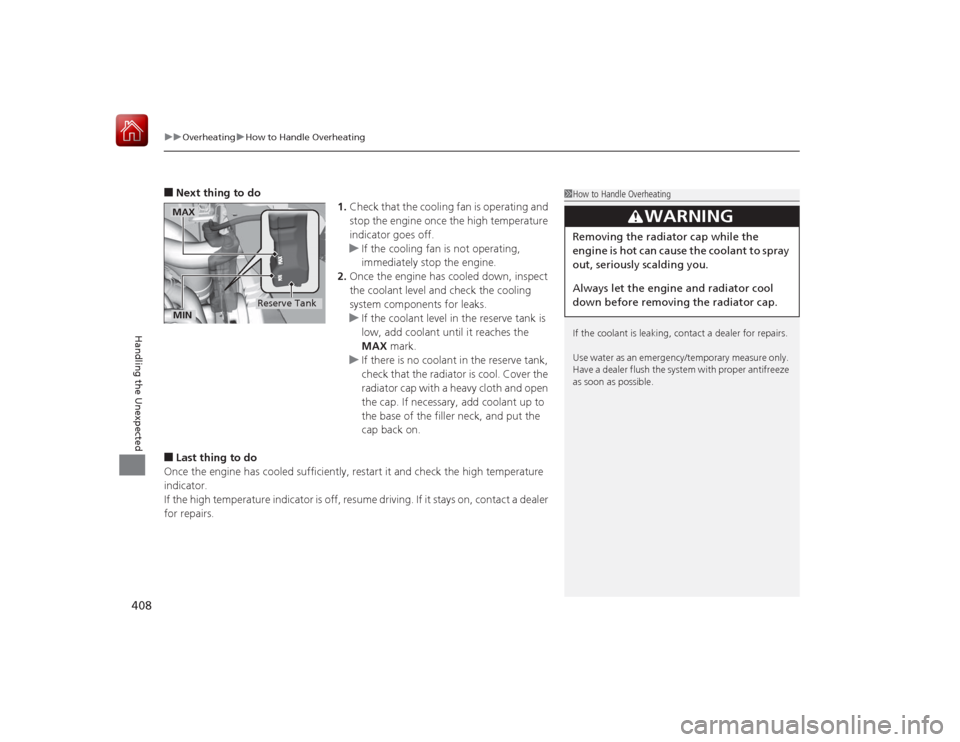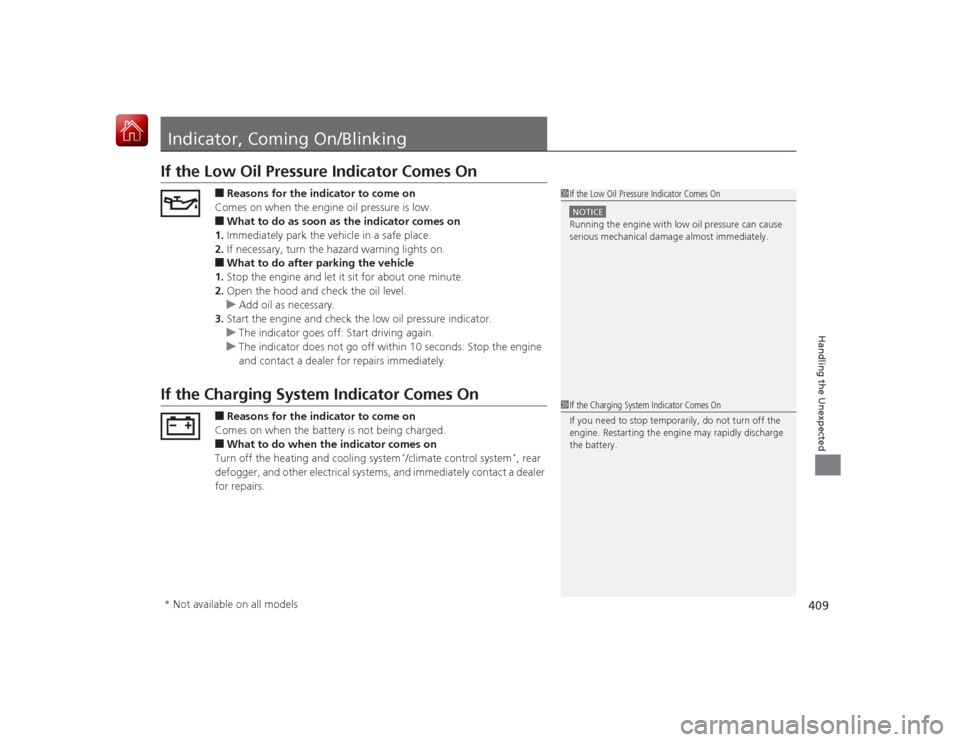2015 HONDA CIVIC COUPE warning
[x] Cancel search: warningPage 394 of 441

393
Continued
Handling the Unexpected
If a Tire Goes FlatChanging a Flat TireIf a tire goes flat while driving, grasp the steering wheel firmly, and brake gradually
to reduce speed. Then, stop in a safe place. Replace the flat tire with a compact
spare tire. Go to a dealer as soon as possible to have the full-size tire repaired or
replaced.
1.Park the vehicle on firm, level, and non-slippery surface, and apply the parking
brake.
2. Put the shift lever in
(P
.
2. Put the shift lever in
(R
.
3. Turn on the hazard warning lights and turn the ignition switch to LOCK
(0
*1.
*1: Models with the smart entry system have an ENGINE START/STOP button instead of an
ignition switch.
1 Changing a Flat Tire
Periodically check the tire pressure of the compact
spare. It should be set to the specified pressure.
Specified Pressure: 60 psi (420 kPa, 4.2 kgf/cm
2)
When driving with the compact spare tire, keep the
vehicle speed under 50 mph (80 km/h). Replace with
a full-size tire as soon as possible.
The compact spare tire and wheel in your vehicle are
specifically for this model. Do not use them with
another vehicle. Do not use another type of compact
spare tire or wheel with your vehicle.
Do not mount tire chains on a compact spare tire.
If a chain-mounted front tire goes flat, remove one of
the full-size rear tires and replace it with the compact
spare tire. Remove the flat front tire and replace it
with the full-size tire th at was removed from the rear.
Mount the tire chains on the front tire.
Continuously variable transmission modelsManual transmission modelsAll models
Page 397 of 441

uuIf a Tire Goes Flat uChanging a Flat Tire
396Handling the Unexpected
1. Place the jack under the jacking point
closest to the tire to be changed.
2. Turn the end bracket clockwise as shown in
the image until the top of the jack contacts
the jacking point.
u Make sure that the jacking point tab is
resting in the jack notch.
3. Raise the vehicle, using the jack handle bar
and the jack handle, until the tire is off the
ground.
■
How to Set Up the Jack
1How to Set Up the Jack
Do not use the jack with people or luggage in the
vehicle.
Use the jack provided in your vehicle.
Other jacks may not support the weight (“load”) or
may not fit the jacking point.
The following instructions must be followed to use
the jack safely:•Do not use while the engine is running.•Use only where the ground is firm and level.•Use only at the jacking points.•Do not get in the vehicle while using the jack.•Do not put anything on top of or underneath the
jack.
3
WARNING
The vehicle can easily roll off the jack,
seriously injuring anyone underneath.
Follow the directions for changing a tire
exactly, and never get under the vehicle
when it is supported only by the jack.
Jack
Handle
Bar Wheel Nut
Wrench as Jack Handle
Page 399 of 441

uuIf a Tire Goes Flat uChanging a Flat Tire
398Handling the Unexpected
5. Lower the vehicle and remove the jack.
Tighten the wheel nuts in the order
indicated in the image. Go around,
tightening the nuts, two to three times in
this order.
Wheel nut torque:
80 lbf∙ft (108 N∙m, 11 kgf∙m)
1. Remove the center cap.
2. Place the flat tire face down in the spare tire
well.
3. Remove the spacer cone from the wing
bolt, flip it over, and insert it back on the
bolt. Secure the flat tire with the wing bolt.
4. Securely put the jack and wheel nut wrench
back in the tool case. Store the case in the
trunk.
■
Storing the Flat Tire
1Storing the Flat Tire
3
WARNING
Loose items can fly around the interior in a
crash and can seriously injure the
occupants.
Store the wheel, jack, and tools securely
before driving.
Spacer
ConeWing
Bolt
For compact spare tireFor full-
size tire
Models with aluminum wheelsAll models
Page 404 of 441

403
Continued
Handling the Unexpected
Jump StartingTurn off the power to electric devices, such as audio and lights. Turn off the engine,
then open the hood. 1.Connect the first jumper cable to your
vehicle's battery + terminal.
2. Connect the other end of the first jumper
cable to the booster battery + terminal.
u Use a 12-volt booster battery only.
u When using an automotive battery
charger to boost your 12-volt battery,
select a lower charging voltage than 15-
volt. Check the charger manual for the
proper setting.
3. Connect the second jumper cable to the
booster battery - terminal.■
Jump Starting Procedure
1Jump Starting
Securely attach the jumper cables clips so that they
do not come off when the engine vibrates. Also be
careful not to tangle the jumper cables or allow the
cable ends to touch each other while attaching or
detaching the jumper cables.
3
WARNING
A battery can explode if you do not follow
the correct procedure, seriously injuring
anyone nearby.
Keep all sparks, open flames, and smoking
materials away from the battery.
Booster Battery1.8 ℓ engine models2.4 ℓ engine modelsBooster Battery
Page 408 of 441

407
Continued
Handling the Unexpected
OverheatingHow to Handle OverheatingOverheating symptoms are as follows:
•The high temperature indicator comes on or the engine suddenly loses power.
• Steam or spray comes out of the engine compartment.■First thing to do
1. Immediately park the vehicle in a safe place.
2. Turn off all accessories and turn on the hazard warning lights.
u No steam or spray present: Keep the engine running and open the hood.
u Steam or spray is present: Turn off the engine and wait until it subsides.
Then open the hood.
1 How to Handle OverheatingNOTICEContinuing to drive with the high temperature
indicator on may damage the engine.
3
WARNING
Steam and spray from an overheated
engine can seriously scald you.
Do not open the ho od if steam is coming
out.
Page 409 of 441

uuOverheating uHow to Handle Overheating
408Handling the Unexpected
■Next thing to do
1.Check that the cooling fan is operating and
stop the engine once the high temperature
indicator goes off.
u If the cooling fan is not operating,
immediately stop the engine.
2. Once the engine has cooled down, inspect
the coolant level and check the cooling
system components for leaks.
u If the coolant level in the reserve tank is
low, add coolant until it reaches the
MAX mark.
u If there is no coolant in the reserve tank,
check that the radiator is cool. Cover the
radiator cap with a heavy cloth and open
the cap. If necessary, add coolant up to
the base of the filler neck, and put the
cap back on.■Last thing to do
Once the engine has co oled sufficiently, restart it and check the high temperature
indicator.
If the high temperature indicator is off, resume driving. If it stays on, contact a dealer
for repairs.
1 How to Handle Overheating
If the coolant is leaking, contact a dealer for repairs.
Use water as an emerge ncy/temporary measure only.
Have a dealer flush the system with proper antifreeze
as soon as possible.
3
WARNING
Removing the radiator cap while the
engine is hot can cause the coolant to spray
out, seriously scalding you.
Always let the engine and radiator cool
down before removing the radiator cap.
MAX
Reserve Tank
MIN
Page 410 of 441

409Handling the Unexpected
Indicator, Coming On/BlinkingIf the Low Oil Pressure Indicator Comes On
■Reasons for the indicator to come on
Comes on when the engine oil pressure is low.■What to do as soon as the indicator comes on
1. Immediately park the vehicle in a safe place.
2. If necessary, turn the hazard warning lights on.■What to do after parking the vehicle
1. Stop the engine and let it sit for about one minute.
2. Open the hood and check the oil level.
u Add oil as necessary.
3. Start the engine and check the low oil pressure indicator.
u The indicator goes off: Start driving again.
u The indicator does not go off within 10 seconds: Stop the engine
and contact a dealer for repairs immediately.
If the Charging System Indicator Comes On
■Reasons for the indicator to come on
Comes on when the battery is not being charged.■What to do when the indicator comes on
Turn off the heating and cooling system
*/climate control system
*, rear
defogger, and other electrical systems, and immediately contact a dealer
for repairs.
1 If the Low Oil Pressure Indicator Comes OnNOTICERunning the engine with low oil pressure can cause
serious mechanical damage almost immediately.1If the Charging System Indicator Comes On
If you need to stop temporarily, do not turn off the
engine. Restarting the engine may rapidly discharge
the battery.
* Not available on all models
Page 437 of 441

436Index
Locations ......................................... 413, 414GGasoline (Fuel)Economy ................................................. 335
Gauge ....................................................... 81
Information ............................................. 332
Instant Fuel Economy ........................... 81, 86
Low Fuel Indicator ..................................... 69
Refueling ................................................. 332
Gauges ......................................................... 81
Gear Shift Lever Positions
Continuously Variable Transmission .................................. 305, 307
Manual Transmission ............................... 312
Glass (care) ................................................ 388
Glove Box .................................................. 147HHalogen Bulbs ........................................... 364
Handling the Unexpected ........................ 391
HandsFreeLink® (HFL) ....................... 233, 264
Automatic Import of Cellular Phonebook and Call History .................................... 249, 276
Automatic Transferring ............................ 247
Caller’s ID Information ............................. 247
Displaying Messages ........................ 260, 285
HFL Buttons ..................................... 233, 264
HFL Menus ...................................... 235, 266 HFL Status Display ........................... 234, 265
Limitations for Manual Operation ............ 234
Making a Call .................................. 253, 279
Options During a Call ...................... 258, 282
Phone Setup.................................... 240, 270
Receiving a Call ............................... 257, 282
Receiving a Text Message/E-mail...... 259, 283
Ring Tone................................................ 275
Selecting a Mail Account ......................... 284
Speed Dial ....................................... 250, 277
Text Message .................. 245, 259, 274, 283
To Clear the System ................................ 248
To Create a Security PIN .......................... 246
To Set Up a Text Message/E-mail
Options ......................................... 245, 274
Hazard Warning Button .............................. 4
Head Restraints ........................................ 139
Headlights ................................................. 127
Aiming .................................................... 360
Automatic Operation............................... 128
Dimming ......................................... 127, 130
Operating................................................ 127
Heaters (Seat) ........................................... 151
Heating and Cooling System ................... 152
Cooling ................................................... 154
Defrosting the Windshield and Windows ............................................... 154
Dust and Pollen Filter............................... 384
Heating ................................................... 153
HFL (HandsFreeLink® )....................... 233, 264
High Beam Indicator .................................. 73 Hill Start Assist System
..................... 299, 302
IIdentification Numbers ............................ 424
Vehicle Identification............................... 424
Ignition Switch ......................................... 122
Illumination Control ................................ 132
Knob ...................................................... 132
i-MID ........................................................... 83
Immobilizer System .................................. 116
Indicator ................................................... 74
Indicators .................................................... 66
Anti-lock Brake System (ABS) .................... 69
Brake System (Amber) ............................... 66
Charging System............................... 67, 409
CRUISE CONTROL ............................. 75, 316
CRUISE MAIN.................................... 75, 315
Door Open.......................................... 29, 71
ECON Mode ..................................... 75, 314
Electric Power Steering (EPS) System ............................................ 72, 411
Fog Light .................................................. 73
High Beam ................................................ 73
High Temperature ..................................... 70
Immobilizer System ................................... 74
i-VTEC ................................................ 75, 82
Lights On .................................................. 73
Low Fuel ................................................... 69
Low Oil Pressure ............................... 67, 409
Low Temperature...................................... 70